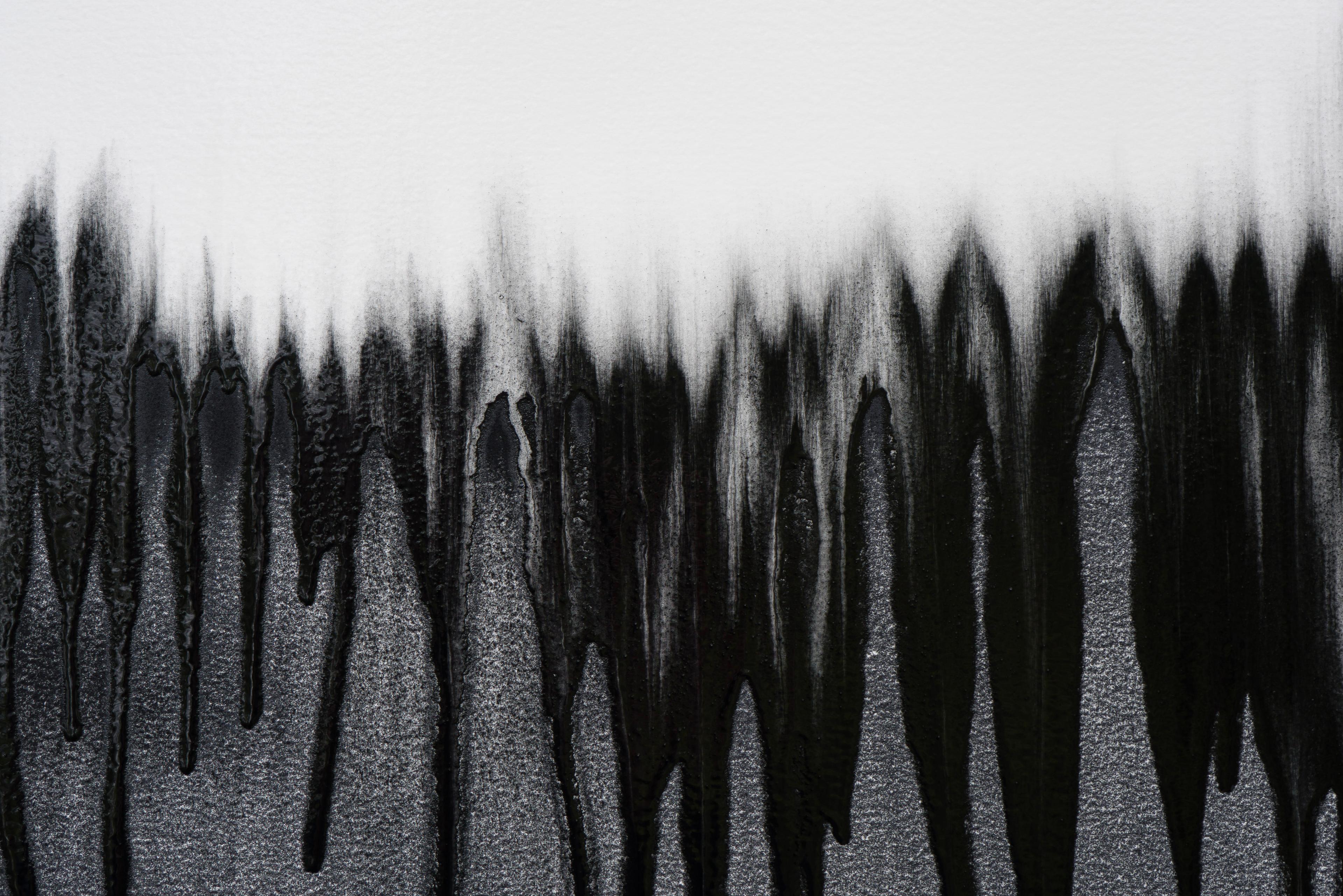- I began Covid #33, one of the later drawings of the series, in my outdoor studio with a heavy application of powdered charcoal along the top margin, as though I were superimposing waves, or graphing a curve.
- Powdered charcoal has a certain density, and it falls freely down the sheet, with some particles trapped by the safflower oil medium, and some drifting away in the currents of forest air. Somehow the movement of the medium has seemed utterly appropriate to the strange vertigo of the moment.
- Working with a stainless steel blade, I made a series of definite, identical gestures — as identical to each other as I could make them — pulling the blade from left to right, creating a small unit square.
- Where there is lots of charcoal, the geometry of the square is marked out and completed. As it thins out, towards the bottom, the gesture serves to produce a literal graphing of particle density, and strange mountain ranges appear.
- The great problem of abstraction is finding a way to make the world appear — in the midst of a series of technical maneuvers that might seem hopelessly distant from the actualities of life. It is here that I had the most difficult decisions to make: generating obscuring clouds of white that disperse and coalesce, and introducing a fine spray of cadmium pigment that gathers force unexpectedly, producing a block of orange that glows with the potential for contamination.
Christopher Campbell
Dispersions
Drawings from a year of COVID
Introduction
In April 2020, as the pandemic hit home, I suddenly had an intuition about a metaphoric connection between the behavior of the materials in my drawings, and the phenomena associated with COVID-19. I could no longer watch a sheet of paper trap a cloud of powdered graphite particles, or follow a rivulet of safflower oil gathering color on its travels, without seeing them as visualizations of aerosol dispersions or tangential infection.
What began as a few medium-scale drawings became a major, year-long project of some fifty works, created on large sheets of Arches paper (130 × 92 cm, 51 × 36 in) specifically designed for oil paint. In the making, there was an exhilarating sense of generative urgency that seemed to lead from one work to the next. In retrospect, the drawings seem to fall into groups as the working process generated new modes of material handling and technique, and I searched for ways to give shape and form not only to the dangerously invisible, but to create a record of a moment beyond our comprehension.
Artist statement
Two works in detail
- With the paper taped to a panel, I started Covid #50 flat on the ground, as that facilitates casting a delicate tracery of lines across the surface. I knew that was where I wanted to start, even if I intended to finish in a very different place.
- To create a softer, secondary linear network that would occupy — and create — a different order of space, I worked with powdered charcoal, drawing with the panel oriented vertically, as though following particles in a cloud chamber.
- To contradict the graceful trajectories, I used a stainless steel blade — loaded with a mixture of ultramarine blue and ivory black — to establish a broken, erratic rhythm, chattering across the surface.
- Using slightly thinned white oil paint, I built an open grid that partially veiled the prior layers of work, obscuring some aspects, but allowing the denser, more concentrated drawing to bloom forward into the wet, receptive white.
- In the final session, I began drawing from a photograph of a mouldering oak, following aspects of the structural disintegration with a heavily loaded brush, leaning towards a dark, ragged mode that speaks of dissolution and collapse. Pulling paint and resin over and under the dark drawing modulated the degree to which it emerges organically from the quasi-geometric underlays, and presses the wet blackness towards not just unpredictability, but alarm and incomprehensibility.
I’m beginning to absorb (no word is innocent here) the COVID drawings, which do seem to be some of your very finest work. And as you say, decisively different from the work gone before, for all the deep continuities. The “imagined" quality you talk about must be part of it. But clearly the drawings are trying to imagine (to image, to give form to) the unimaginable, or at least to something dangerously, deceptively un-seeable — but a reality nonetheless, of dissemination, “infection,” “communication,” that is here with us, too close, too omnipresent. You are calling on the repertoire of marks and shapes and rhythms that have come out of long years looking to “face up to” an invisible (hidden) face of nature. The result is, as you say, a kind of certainty. Most “certainty” in art these days seems to me to be built on too flimsy a foundation — the artist knows what he or she is doing too soon, the tasks they've set themselves are too simple. Your certainty is different. It's what arrives when a “crisis” comes, and asks for a response, and a previous “language” and “procedure” is there, at your disposal — how it is, isn't clear, even to you — asked to do new things, asked to do things it might even previously have distrusted (like “drawing the imagined”).
What I admire most about the COVID drawings is (as maybe I tried to say previously) that their dangerous “abstractness” is obliged to admit that it is in search, naively, by fiat, in ways it doesn't understand, for the “feel” of a whole time…a time of vulnerability, contamination, loss of bearings, “being out of touch”…
—Art historian Timothy J. Clark
